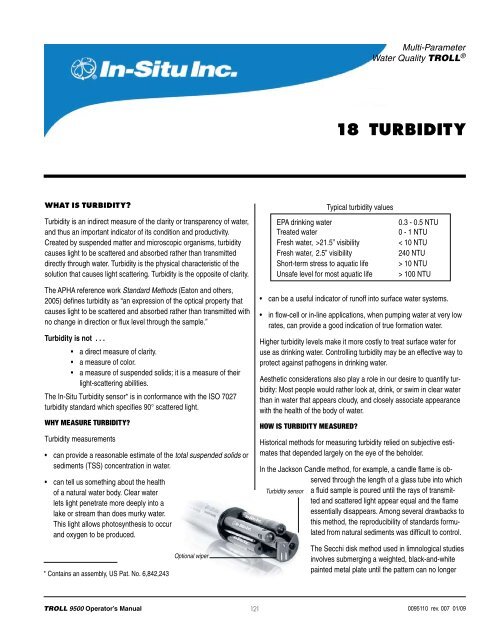TROLL 9500 Operator's Manual - Geotech Environmental Equipment
TROLL 9500 Operator's Manual - Geotech Environmental Equipment
TROLL 9500 Operator's Manual - Geotech Environmental Equipment
You also want an ePaper? Increase the reach of your titles
YUMPU automatically turns print PDFs into web optimized ePapers that Google loves.
Multi-ParameterWater Quality <strong>TROLL</strong> ®18 TurbidityWhat Is Turbidity?Turbidity is an indirect measure of the clarity or transparency of water,and thus an important indicator of its condition and productivity.Created by suspended matter and microscopic organisms, turbiditycauses light to be scattered and absorbed rather than transmitteddirectly through water. Turbidity is the physical characteristic of thesolution that causes light scattering. Turbidity is the opposite of clarity.Typical turbidity valuesEPA drinking waterTreated waterFresh water, >21.5” visibilityFresh water, 2.5” visibilityShort-term stress to aquatic lifeUnsafe level for most aquatic life0.3 - 0.5 NTU0 - 1 NTU< 10 NTU240 NTU> 10 NTU> 100 NTUThe APHA reference work Standard Methods (Eaton and others,2005) defines turbidity as “an expression of the optical property thatcauses light to be scattered and absorbed rather than transmitted withno change in direction or flux level through the sample.”Turbidity is not . . .• a direct measure of clarity.• a measure of color.• a measure of suspended solids; it is a measure of theirlight-scattering abilities.The In-Situ Turbidity sensor* is in conformance with the ISO 7027turbidity standard which specifies 90° scattered light.Why Measure Turbidity?Turbidity measurements• can provide a reasonable estimate of the total suspended solids orsediments (TSS) concentration in water.• can tell us something about the healthof a natural water body. Clear waterlets light penetrate more deeply into alake or stream than does murky water.This light allows photosynthesis to occurand oxygen to be produced.* Contains an assembly, US Pat. No. 6,842,243Optional wiper• can be a useful indicator of runoff into surface water systems.• in flow-cell or in-line applications, when pumping water at very lowrates, can provide a good indication of true formation water.Higher turbidity levels make it more costly to treat surface water foruse as drinking water. Controlling turbidity may be an effective way toprotect against pathogens in drinking water.Aesthetic considerations also play a role in our desire to quantify turbidity:Most people would rather look at, drink, or swim in clear waterthan in water that appears cloudy, and closely associate appearancewith the health of the body of water.How Is Turbidity Measured?Historical methods for measuring turbidity relied on subjective estimatesthat depended largely on the eye of the beholder.In the Jackson Candle method, for example, a candle flame is observedthrough the length of a glass tube into whichTurbidity sensor a fluid sample is poured until the rays of transmittedand scattered light appear equal and the flameessentially disappears. Among several drawbacks tothis method, the reproducibility of standards formulatedfrom natural sediments was difficult to control.The Secchi disk method used in limnological studiesinvolves submerging a weighted, black-and-whitepainted metal plate until the pattern can no longer<strong>TROLL</strong> <strong>9500</strong> Operator’s <strong>Manual</strong> 1210095110 rev. 007 01/09
















